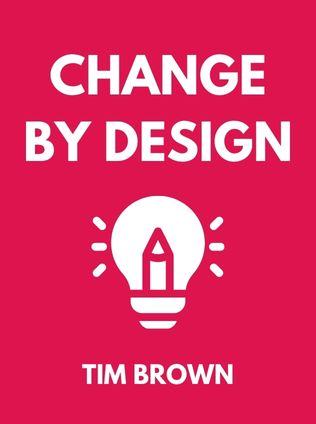
Change by Design
How Design Thinking Transforms Organizations and Inspires Innovation
By Tim Brown
Published 03/2019
About the Author
Tim Brown is the CEO and president of IDEO, a global design consultancy that has consistently ranked among the top ten most innovative companies in the world. Under his leadership, IDEO has been responsible for groundbreaking innovations such as the first Apple mouse and the Palm V. Brown advises senior executives and boards of Fortune 100 companies, fostering strategic relationships with giants like Microsoft, PepsiCo, and Procter & Gamble. His work is a testament to the power of design thinking in transforming not only products but also entire organizations.
Main Idea
"Change by Design" dispels the myth that innovation is the product of lone geniuses working in isolation. Instead, it presents a compelling argument for design thinking as a collaborative, human-centered approach to problem-solving and innovation. Design thinking is not about making things pretty; it is about creating solutions that are functional, viable, and desirable. This methodology can be applied to a wide range of challenges, from developing new products to addressing complex societal issues like climate change and public health.
Table of Contents
- Introduction: The Power of Design Thinking
- What is Design Thinking?
- Converting Need into Demand
- Building to Think
- Spreading the Message
- The New Social Contract
- Design Activism
- Designing Tomorrow - Today
Introduction: The Power of Design Thinking
Tim Brown introduces the concept of design thinking, emphasizing its importance in today's rapidly changing world. He argues that design thinking has moved beyond the confines of the design studio and into the boardrooms of the most progressive companies. This shift reflects a growing recognition that design is a strategic asset, capable of addressing a wide range of challenges.
"Today, rather than enlist designers to make an already developed idea more attractive, the most progressive companies are challenging them to create ideas at the outset of the development process. The former role is tactical; it builds on what exists and usually moves it one step further. The latter is strategic; it pulls 'design' out of the studio and unleashes its disruptive, game-changing potential." –
Tim Brown
What is Design Thinking?
Design thinking is a non-linear, iterative process that involves inspiration, ideation, and implementation. Unlike traditional problem-solving methods, it is open-ended, open-minded, and often feels chaotic to those experiencing it for the first time. This approach allows for unexpected discoveries and encourages teams to refine or rethink their assumptions.
Sign up for FREE and get access to 1,400+ books summaries.
You May Also Like
The Life-Changing Magic of Tidying Up
The Japanese Art of Decluttering and Organizing
By Marie KondoThe Lean Startup
How Today's Entrepreneurs Use Continuous Innovation to Create Radically Successful Businesses
By Eric RiesWho Moved My Cheese?
An Amazing Way to Deal with Change in Your Work and in Your Life
By Spencer Johnson, M.D.Make Your Bed
Little Things That Can Change Your Life...And Maybe the World
By William H. McRaven



















